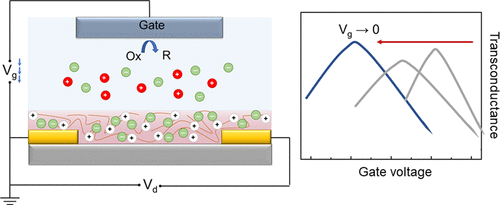当前位置:
X-MOL 学术
›
ACS Appl. Mater. Interfaces
›
论文详情
Our official English website, www.x-mol.net, welcomes your
feedback! (Note: you will need to create a separate account there.)
Tuning Organic Electrochemical Transistor (OECT) Transconductance toward Zero Gate Voltage in the Faradaic Mode
ACS Applied Materials & Interfaces ( IF 8.3 ) Pub Date : 2021-10-13 , DOI: 10.1021/acsami.1c13009 Songyan Yu 1 , Erin L Ratcliff 1, 2, 3
ACS Applied Materials & Interfaces ( IF 8.3 ) Pub Date : 2021-10-13 , DOI: 10.1021/acsami.1c13009 Songyan Yu 1 , Erin L Ratcliff 1, 2, 3
Affiliation

|
In this work, we investigate material design criteria for low-powered/self-powered and efficient organic electrochemical transistors (OECTs) to be operated in the faradaic mode (detection at the gate electrode occurs via electron transfer events). To rationalize device design principles, we adopt a Marcus–Gerischer perspective for electrochemical processes at both the gate and channel interfaces. This perspective considers density of states (DOS) for the semiconductor channel, the gate electrode, and the electrolyte. We complement our approach with energy band offsets of relevant electrochemical potentials that can be independently measured from transistor geometry using conventional electrochemical methods as well as an approach to measure electrolyte potential in an operating OECT. By systematically changing the relative redox property offsets between the redox-active electrolyte and semiconducting polymer channel, we demonstrate a first-order design principle that necessary gate voltage is minimized by good DOS overlap of the two redox processes at the gate and channel. Specifically, for p-type turn-on OECTs, the voltage-dependent, electrochemically active semiconductor DOS should overlap with the oxidant form of the electrolyte to minimize the onset voltage for transconductance. A special case where the electrolyte can be used to spontaneously dope the polymer via charge transfer is also considered. Collectively, our results provide material design pathways toward the development of simple, robust, power-saving, and high-throughput OECT biosensors.
中文翻译:

在法拉第模式下将有机电化学晶体管 (OECT) 跨导调整到零栅极电压
在这项工作中,我们研究了以法拉第模式运行的低功率/自供电和高效有机电化学晶体管 (OECT) 的材料设计标准(栅电极处的检测通过电子转移事件发生)。为了使器件设计原则合理化,我们采用 Marcus-Gerischer 的观点来处理栅极和通道界面的电化学过程。这个观点考虑了半导体通道、栅电极和电解质的状态密度 (DOS)。我们用相关电化学电位的能带偏移对我们的方法进行了补充,这些电化学电位可以使用传统的电化学方法从晶体管几何形状独立测量,以及在运行的 OECT 中测量电解质电位的方法。通过系统地改变氧化还原活性电解质和半导体聚合物通道之间的相对氧化还原性能偏移,我们展示了一个一阶设计原则,即通过栅极和通道处两个氧化还原过程的良好 DOS 重叠来最小化必要的栅极电压。具体而言,对于 p 型导通 OECT,电压相关的电化学活性半导体 DOS 应与电解质的氧化剂形式重叠,以最小化跨导的起始电压。还考虑了一种特殊情况,其中电解质可用于通过电荷转移自发地掺杂聚合物。总的来说,我们的结果为开发简单、坚固、节能和高通量的 OECT 生物传感器提供了材料设计途径。我们展示了一个一阶设计原则,即通过栅极和沟道处两个氧化还原过程的良好 DOS 重叠来最小化必要的栅极电压。具体而言,对于 p 型导通 OECT,电压相关的电化学活性半导体 DOS 应与电解质的氧化剂形式重叠,以最小化跨导的起始电压。还考虑了一种特殊情况,其中电解质可用于通过电荷转移自发掺杂聚合物。总的来说,我们的结果为开发简单、坚固、节能和高通量的 OECT 生物传感器提供了材料设计途径。我们展示了一个一阶设计原则,即通过栅极和沟道处两个氧化还原过程的良好 DOS 重叠来最小化必要的栅极电压。具体而言,对于 p 型导通 OECT,电压相关的电化学活性半导体 DOS 应与电解质的氧化剂形式重叠,以最小化跨导的起始电压。还考虑了一种特殊情况,其中电解质可用于通过电荷转移自发掺杂聚合物。总的来说,我们的研究结果为开发简单、坚固、省电和高通量的 OECT 生物传感器提供了材料设计途径。电压依赖性、电化学活性半导体 DOS 应与电解质的氧化剂形式重叠,以最小化跨导的起始电压。还考虑了一种特殊情况,其中电解质可用于通过电荷转移自发掺杂聚合物。总的来说,我们的结果为开发简单、坚固、节能和高通量的 OECT 生物传感器提供了材料设计途径。电压依赖性、电化学活性半导体 DOS 应与电解质的氧化剂形式重叠,以最小化跨导的起始电压。还考虑了一种特殊情况,其中电解质可用于通过电荷转移自发掺杂聚合物。总的来说,我们的结果为开发简单、坚固、节能和高通量的 OECT 生物传感器提供了材料设计途径。
更新日期:2021-10-27
中文翻译:

在法拉第模式下将有机电化学晶体管 (OECT) 跨导调整到零栅极电压
在这项工作中,我们研究了以法拉第模式运行的低功率/自供电和高效有机电化学晶体管 (OECT) 的材料设计标准(栅电极处的检测通过电子转移事件发生)。为了使器件设计原则合理化,我们采用 Marcus-Gerischer 的观点来处理栅极和通道界面的电化学过程。这个观点考虑了半导体通道、栅电极和电解质的状态密度 (DOS)。我们用相关电化学电位的能带偏移对我们的方法进行了补充,这些电化学电位可以使用传统的电化学方法从晶体管几何形状独立测量,以及在运行的 OECT 中测量电解质电位的方法。通过系统地改变氧化还原活性电解质和半导体聚合物通道之间的相对氧化还原性能偏移,我们展示了一个一阶设计原则,即通过栅极和通道处两个氧化还原过程的良好 DOS 重叠来最小化必要的栅极电压。具体而言,对于 p 型导通 OECT,电压相关的电化学活性半导体 DOS 应与电解质的氧化剂形式重叠,以最小化跨导的起始电压。还考虑了一种特殊情况,其中电解质可用于通过电荷转移自发地掺杂聚合物。总的来说,我们的结果为开发简单、坚固、节能和高通量的 OECT 生物传感器提供了材料设计途径。我们展示了一个一阶设计原则,即通过栅极和沟道处两个氧化还原过程的良好 DOS 重叠来最小化必要的栅极电压。具体而言,对于 p 型导通 OECT,电压相关的电化学活性半导体 DOS 应与电解质的氧化剂形式重叠,以最小化跨导的起始电压。还考虑了一种特殊情况,其中电解质可用于通过电荷转移自发掺杂聚合物。总的来说,我们的结果为开发简单、坚固、节能和高通量的 OECT 生物传感器提供了材料设计途径。我们展示了一个一阶设计原则,即通过栅极和沟道处两个氧化还原过程的良好 DOS 重叠来最小化必要的栅极电压。具体而言,对于 p 型导通 OECT,电压相关的电化学活性半导体 DOS 应与电解质的氧化剂形式重叠,以最小化跨导的起始电压。还考虑了一种特殊情况,其中电解质可用于通过电荷转移自发掺杂聚合物。总的来说,我们的研究结果为开发简单、坚固、省电和高通量的 OECT 生物传感器提供了材料设计途径。电压依赖性、电化学活性半导体 DOS 应与电解质的氧化剂形式重叠,以最小化跨导的起始电压。还考虑了一种特殊情况,其中电解质可用于通过电荷转移自发掺杂聚合物。总的来说,我们的结果为开发简单、坚固、节能和高通量的 OECT 生物传感器提供了材料设计途径。电压依赖性、电化学活性半导体 DOS 应与电解质的氧化剂形式重叠,以最小化跨导的起始电压。还考虑了一种特殊情况,其中电解质可用于通过电荷转移自发掺杂聚合物。总的来说,我们的结果为开发简单、坚固、节能和高通量的 OECT 生物传感器提供了材料设计途径。











































 京公网安备 11010802027423号
京公网安备 11010802027423号